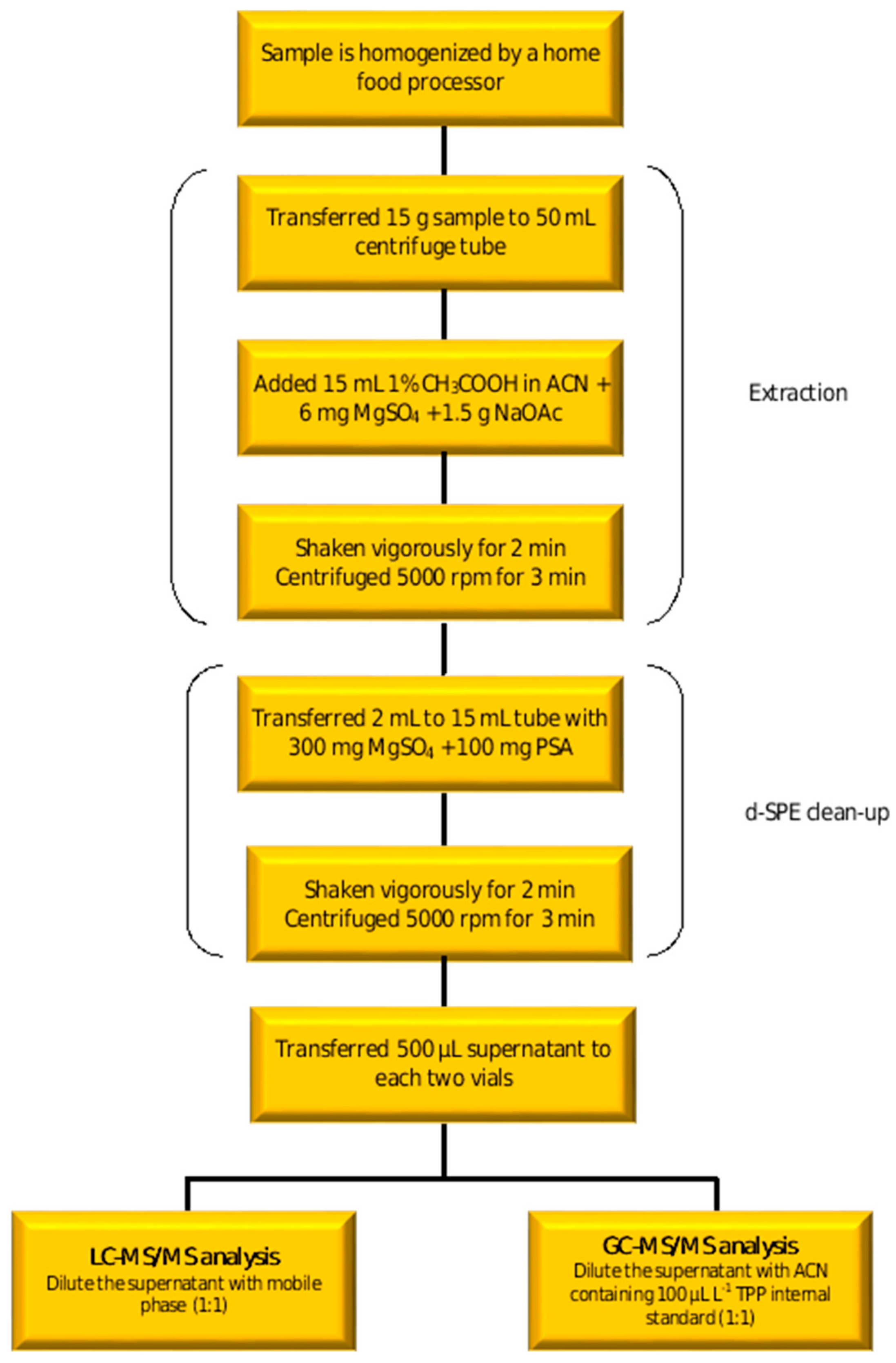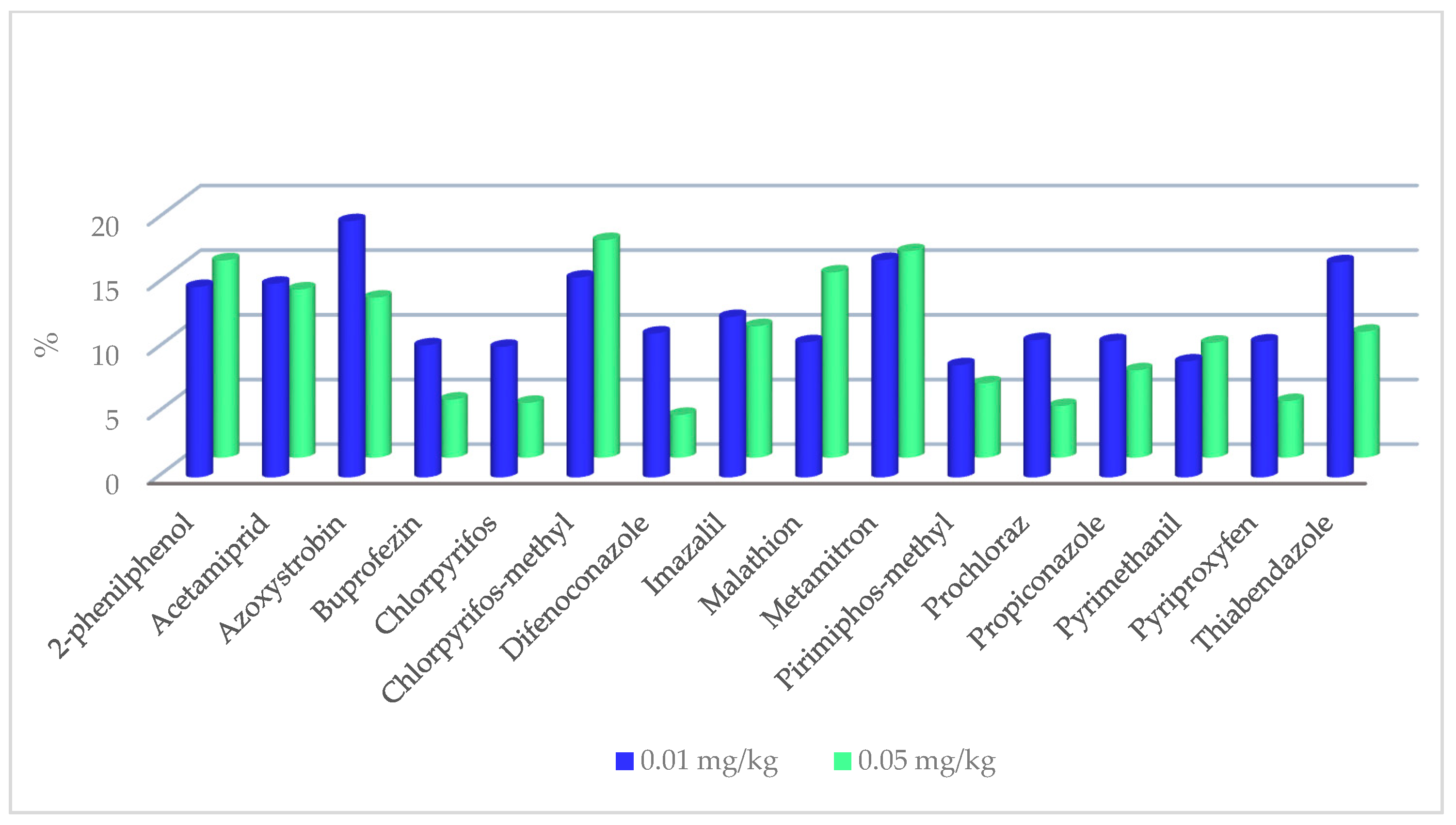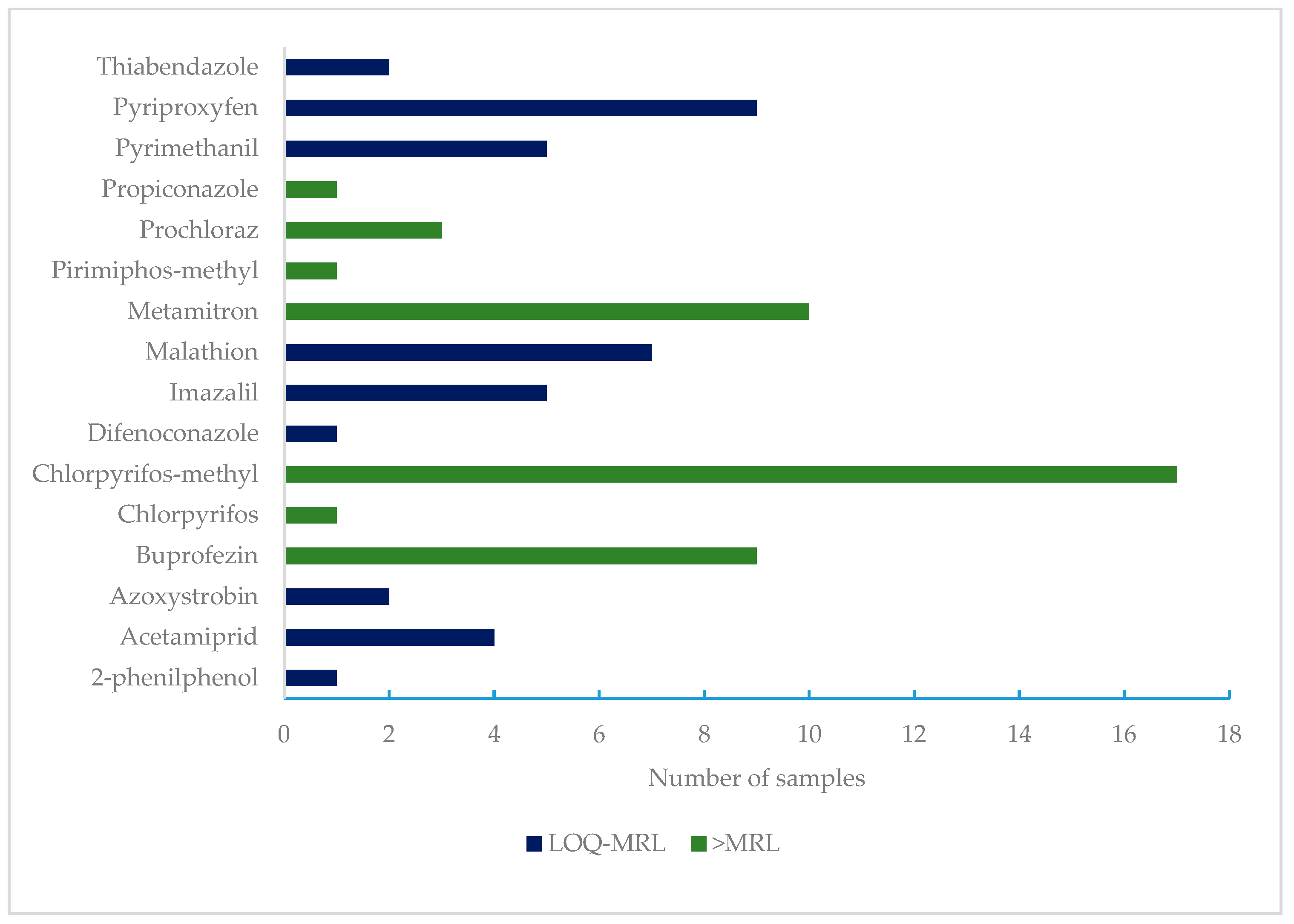Determination of 355 Pesticides in Lemon and Lemon Juice by LC-MS/MS and GC-MS/MS
Abstract
1. Introduction
2. Materials and Methods
2.1. Standards, Chemicals and Reagents
2.2. Samples
2.3. Sample Preparation
2.4. LC-MS/MS Analysis
2.5. GC-MS/MS Analysis
2.6. Method Validation
3. Results
3.1. Method Validation Data
3.2. Pesticide Residues in Whole Lemon Fruit and Lemon Juice
4. Conclusions
Supplementary Materials
Author Contributions
Funding
Data Availability Statement
Conflicts of Interest
References
- FAO (Food and Agricultural Organization). FAO Statistical Databases and Data Sets; FAO (Food and Agricultural Organization): Rome, Italy, 2022. Available online: https://www.fao.org/faostat/en/#data/QC/visualize (accessed on 17 January 2023).
- Demir, G. Limon Yetiştiriciliği; Batı Akdeniz Tarımsal Araştırma Enstitüsü Müdürlüğü (BATEM): Antalya, Turkey, 2020. Available online: https://arastirma.tarimorman.gov.tr/batem/Belgeler/Kutuphane/Teknik%20Bilgiler/Limon%20Yetistiriciligi.pdf (accessed on 23 January 2023).
- Janati, S.S.F.; Beheshti, H.R.; Feizy, J.; Fahim, N.K. Chemical composition of lemon (Citrus limon) and peels its considerations as animal food. Gıda 2012, 37, 267–271. [Google Scholar]
- Del Río, J.A.; Fuster, M.D.; Gómez, P.; Porras, I.; Garcia-Lidón, A.; Ortuño, A. Citrus limon: A source of flavonoids of pharmaceutical interest. Food Chem. 2004, 84, 457–461. [Google Scholar] [CrossRef]
- Klimek-Szcykutowicz, M.; Szopa, A.; Ekiert, H. Citrus limon (lemon) phenomenon-a-review of the chemistry, pharmacological properties, applications in the modern pharmaceutical, food, and cosmetics industries, and biotechnological studies. Plants 2020, 9, 119. [Google Scholar] [CrossRef] [PubMed]
- Magalhães, D.; Vilas-Boas, A.A.; Teixeira, P.; Pintado, M. Functional ingredients and additives from lemon by-products and their applications in food preservation: A review. Foods 2023, 12, 1095. [Google Scholar] [CrossRef] [PubMed]
- Goodrich, R. Citrus fruits. In Encylopedia of Food Sciences and Nutrition, 2nd ed.; Caballero, B., Ed.; Academic Press: Cambridge, MA, USA; Elsevier: Amsterdam, The Netherlands, 2003; pp. 1354–1359. [Google Scholar]
- El-Otmani, M.; Ait-Oubahou, A.; Zacarías, L. Citrus spp.: Orange, mandarin, tangerine, clementine, grapefruit, pomelo, lemon and lime. In Postharvest Biology and Technology of Tropical and Subtropical Fruits; Yahia, E.M., Ed.; Woodhead Publishing: Cambridge, UK, 2011; pp. 437–516. [Google Scholar]
- Cerioni, L.; Sepulveda, M.; Rubio-Ames, Z.; Volentini, S.I.; Rodríguez-Montelongo, L.; Smilanick, J.L.; Rapisarda, V.A. Control of lemon postharvest diseases by low-toxicity salts combined with hydrogen peroxide and heat. Postharvest Biol. Technol. 2013, 83, 17–21. [Google Scholar] [CrossRef]
- Fenik, J.; Tankiewicz, M.; Biziuk, M. Properties and determination of pesticides in fruits and vegetables. Trends Anal. Chem. 2011, 30, 814–826. [Google Scholar] [CrossRef]
- Alavanja, M.C.R.; Matthew, K.R.; Matthew, R.B. Increased cancer burden among pesticide applicators and others due to pesticide exposure. CA Cancer J. Clin. 2013, 63, 120–142. [Google Scholar] [CrossRef]
- Resmi Gazete. Türk Gıda Kodeksi Pestisitlerin Maksimum Kalıntı Limitleri Yönetmeliği. Resmi Gazete, 27 Eylül 2021 Pazartesi, sayı: 31611. Available online: https://kg.com.tr/turk-gida-kodeksi-pestisitlerin-maksimum-kalinti-limitleri-yonetmeligi-hk/ (accessed on 23 January 2023).
- European Commission. Regulation (EC) no 396/2005 of the European Parliament and of the council of 23 February 2005 on maximum residue levels of pesticides in or on food and feed of plant and animal origin and amending Council Directive 91/414/EEC. Off. J. EU 2005, L70, 1–16. [Google Scholar]
- EFSA (European Food Safety Authority). Pilot study on uncertainty analysis in EFSA reasoned opinions on the modification of pesticide maximum residue levels. EFSA J. 2017, 15, 4906. [Google Scholar]
- Azar, İ.; Kıvan, M. Bursa’da pazardan alınan limonlarda bazı insektisit kalıntılarının belirlenmesi. In Proceedings of the Türkiye III. Bitki Koruma Kongresi Bildirileri, Van, Türkiye, 15–18 July 2009; p. 16. Available online: https://www.researchgate.net/profile/Natalija-Atanasova-Pancevska/publication/319877046_Characterization_of_An_Antimicrobial_Extract_From_Tomato_Leaves_Obtained_by_Freeze-_Drying_Effective_on_A_Tomato_Pathogen_Fusarium_spp_Karakterizasyonu/links/59bf8d6e458515e9cfd50a66/Characterization-of-An-Antimicrobial-Extract-From-Tomato-Leaves-Obtained-by-Freeze-Drying-Effective-on-A-Tomato-Pathogen-Fusarium-spp-Karakterizasyonu.pdf (accessed on 23 January 2023).
- Ersoy, N.; Tatlı, Ö.; Özcan, S.; Evcil, E.; Coşkun, L.Ş.; Erdoğan, E. Pesticide residues in some tropical and subtropical fruit species. Selçuk J. Agric. Food Sci. 2011, 25, 81–88. [Google Scholar]
- Bakırcı, G.T.; Acay, D.B.Y.; Bakırcı, F.; Ötleş, S. Pesticide residues in fruits and vegetables from the Aegean region, Turkey. Food Chem. 2014, 160, 379–392. [Google Scholar] [CrossRef] [PubMed]
- Dincay, O.; Civelek, H.S. Determination of insecticide residues in citrus ecosystems of Ortaca–Muğla region. Türk. Entomol. Bült. 2017, 7, 31–40. [Google Scholar]
- Besil, N.; Rezende, S.; Alonzo, N.; Cesio, M.V.; Rivas, F.; Heinzen, H. Analytical methods for the routinely evaluation of pesticide residues in lemon fruits and by products. SN Appl. Sci. 2019, 1, 618. [Google Scholar] [CrossRef]
- Kaya, T.; Tuna, A.L. Investigation of pesticide residue levels in fruit and vegetables collected from three farmers market in Izmir province. Turk. J. Agric. Res. 2019, 6, 32–38. [Google Scholar]
- Chen, K.-H.; Li, Y.-C.; Sheu, F.; Lin, C.-H. Rapid screening and determination of pesticides in lemon surfaces using the paper-spray mass spectrometry integrated via thermal desorption probe. Food Chem. 2021, 363, 130305. [Google Scholar] [CrossRef] [PubMed]
- Granados-Povedano, M.; Domínguez, I.; Egea-González, F.; Frenich, A.G.; Arrebola, F.J. Unified method for target and non-target monitoring of pesticide residues in fruits and fruit juices by gas chromatography-high resolution mass spectrometry. Foods 2023, 12, 739. [Google Scholar] [CrossRef]
- RASFF (Rapid Alert System for Food and Feed). RASFF Portal. Available online: https://webgate.ec.europa.eu/rasff-winndow/screen/search (accessed on 20 February 2023).
- European Commission. Commission implementing regulation (EU) 2019/1793 of 22 October 2019 on the temporary increase of official controls and emergency measures governing the entry into the Union of certain goods from certain third countries implementing Regulations (EU) 2017/625 and (EC) No 178/2002 of the European Parliament and of the Council and repealing Commission Regulations (EC) No 669/2009, (EU) No 884/2014, (EU) 2015/175, (EU) 2017/186 and (EU) 2018/1660. Off. J. EU 2019, L277, 89–129. [Google Scholar]
- AOAC International. Pesticide residues in food by acetonitrile extraction and partitioning with magnesium sulphate. In AOAC Official Method 2007.01; AOAC: Arlington, VA, USA, 2007. [Google Scholar]
- European Commission. Guide Document on Analytical Quality Control and Method Validation Procedures for Pesticide Residues Analysis in Food and Feed; Document No. SANTE 11312/2021; EC Directorate-General for Health and Food Safety: Brussels, Belgium, 2021.
- Ellison, S.L.R.; Rosselin, M.; Williams, A. Quantifying uncertainty in analytical measurement. Eurachem/CITAC Guide 2000, CG4, 1–20. [Google Scholar]
- Deborah, C.; Smegal, M.P.H. Human Health Risk Assessment: Chlorpyrifos; U.S. Environnmental Protection Agency Office of Pesticide Programs Health Effects Division (7509 C): Washington, DC, USA, 2000; p. 131.
- EFSA (European Food Safety Authority). Conclusion on the peer review of the pesticide human health risk assessment of the active substance chlorpyrifos. EFSA J. 2014, 12, 3640. [Google Scholar]
- EFSA (European Food Safety Authority). Statement on the available outcomes of the human assessment in the context of the pesticides peer review of the active substance chlorpyrifos. EFSA J. 2019, 17, 5809. [Google Scholar]
- EFSA (European Food Safety Authority). Update statement on the available outcomes of the human assessment in the context of the pesticides peer review of the active substance chlorpyrifos-methyl. EFSA J. 2019, 17, 5908. [Google Scholar]
- Stander, O.P.J.; Botes, J.; Krogscheepers, C. The potential use of metamitron as a chemical fruit-thinning agent inn mandarin. Horttech 2018, 28, 28–34. [Google Scholar] [CrossRef]
- Golge, O.; Kabak, B. Determination of 115 pesticide residues in oranges by high-performance liquid chromatography-triple-quadrupole mass spectrometry in combination with QuEChERS method. J. Food Compos. Anal. 2015, 41, 86–97. [Google Scholar] [CrossRef]
- Ortelli, D.; Edder, P.; Corvi, C. Pesticide residues survey in citrus fruits. Food Addit. Contam. 2005, 22, 423–428. [Google Scholar] [CrossRef] [PubMed]
- Calvaruso, E.; Cammilleri, G.; Pulvirenti, A.; Lo Dico, G.M.; Lo Cascio, G.; Giaccone, V.; Ferrantelli, V. Residues of 165 pesticides in citrus fruits using LC-MS/MS: A study of the pesticides distribution from the peel to the pulp. Nat. Product Res. 2020, 34, 34–38. [Google Scholar] [CrossRef] [PubMed]
- Poulsen, M.E.; Andersen, J.H.; Petersen, A.; Jensen, B.H. Results from the Danish monitoring programme for pesticide residues from the period 2004–2011. Food Control 2017, 74, 25–33. [Google Scholar] [CrossRef]
- EFSA (European Food Safety Authority). The 2019 European Union report on pesticide residues in food. EFSA J. 2021, 19, 6491. [Google Scholar]
- Omeroglu, P.Y.; Celik, B.A.; Alibasoglu, E.K. The effect of household food processing in pesticide residues in oranges (Citrus sinensis). Foods 2022, 11, 3918. [Google Scholar] [CrossRef]
- Li, Y.; Jiao, B.; Zhao, Q.; Wang, C.; Gong, Y.; Zhang, Y.; Chen, W. Effect of Commercial Processing on Pesticide Residues in Orange Products. Eur. Food Res. Technol. 2012, 234, 449–456. [Google Scholar] [CrossRef]
- Kaushik, G.; Satya, S.; Naik, S.N. Food processing a tool to pesticide residue dissipation-A review. Food Res. Int. 2009, 42, 26–40. [Google Scholar] [CrossRef]
- Holland, P.T.; Hamilton, D.; Ohlin, B.; Skidmore, M.W. Effects of storage and processing on pesticide residues in plant products. IUPAC Reports on Pesticides. Pure Appl. Chem. 1994, 66, 335–356. [Google Scholar] [CrossRef]
- Kowalska, G.; Pankiewicz, U.; Kowalski, R. Assessment of pesticide content in apples and selected citrus fruits subjected to simple culinary processing. Foods 2022, 12, 1417. [Google Scholar] [CrossRef]
- Awasthi, M.D. Decontamination of insecticide residues on mango by washing and peeling. J. Food Sci. Technol. 1993, 30, 132–133. [Google Scholar]




| Time (min) | Mobile Phase A% a | Mobile Phase B% b | Flow (mL min−1) |
|---|---|---|---|
| 0.0 | 100 | 0 | 0.3 |
| 0.5 | 100 | 0 | 0.3 |
| 7.0 | 30 | 70 | 0.3 |
| 9.0 | 0 | 100 | 0.3 |
| 12.0 | 0 | 100 | 0.3 |
| 12.1 | 100 | 0 | 0.3 |
| 18.0 | 100 | 0 | 0.3 |
| Parameter | Chromatographic Conditions | ||
|---|---|---|---|
| Column | TraceGoldTM TG-5MS (30 m × 0.25 mm × 0.25 µm, ThermoFisher Scientific) | ||
| Injection mode | Splitless | ||
| Splitless time | 1.5 min | ||
| Injection volume | 1 µL | ||
| Carrier gas (purity) | Helium (99.999%) | ||
| Column temperature program | Rate (°C/min) | Temperature (°C) | Hold time (min) |
| 40 | 1.5 | ||
| 25 | 90 | 1.5 | |
| 25 | 180 | 0 | |
| 5 | 280 | 0 | |
| 10 | 300 | 4 | |
| Parameters | MS conditions | ||
| MS transfer line temperature | 280 °C | ||
| Ion source temperature | 280 °C | ||
| Ionisation type | Electron ionisation (EI) | ||
| Measurement mode | Multiple reaction monitoring (MRM) | ||
| Collision gas and pressure (psi) | Argon at 60 | ||
Disclaimer/Publisher’s Note: The statements, opinions and data contained in all publications are solely those of the individual author(s) and contributor(s) and not of MDPI and/or the editor(s). MDPI and/or the editor(s) disclaim responsibility for any injury to people or property resulting from any ideas, methods, instructions or products referred to in the content. |
© 2023 by the authors. Licensee MDPI, Basel, Switzerland. This article is an open access article distributed under the terms and conditions of the Creative Commons Attribution (CC BY) license (https://creativecommons.org/licenses/by/4.0/).
Share and Cite
Aslantas, S.; Golge, O.; González-Curbelo, M.Á.; Kabak, B. Determination of 355 Pesticides in Lemon and Lemon Juice by LC-MS/MS and GC-MS/MS. Foods 2023, 12, 1812. https://doi.org/10.3390/foods12091812
Aslantas S, Golge O, González-Curbelo MÁ, Kabak B. Determination of 355 Pesticides in Lemon and Lemon Juice by LC-MS/MS and GC-MS/MS. Foods. 2023; 12(9):1812. https://doi.org/10.3390/foods12091812
Chicago/Turabian StyleAslantas, Sule, Ozgur Golge, Miguel Ángel González-Curbelo, and Bulent Kabak. 2023. "Determination of 355 Pesticides in Lemon and Lemon Juice by LC-MS/MS and GC-MS/MS" Foods 12, no. 9: 1812. https://doi.org/10.3390/foods12091812
APA StyleAslantas, S., Golge, O., González-Curbelo, M. Á., & Kabak, B. (2023). Determination of 355 Pesticides in Lemon and Lemon Juice by LC-MS/MS and GC-MS/MS. Foods, 12(9), 1812. https://doi.org/10.3390/foods12091812








